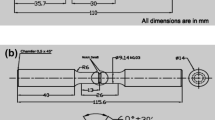Abstract
Presence of hydrogen in materials is known to affect their mechanical properties due to hydrogen embrittlement problem. Steels used in various applications are prone to be exposed to aqueous electrochemical environments, which may introduce hydrogen into the alloy. These alloys are also prone to be simultaneously exposed to magnetic field, which may affect the hydrogen embrittlement susceptibility of these alloys. Therefore, it is important to examine the effect of hydrogen and magnetic field on the mechanical behavior of iron-based alloys. In this work, the effect of hydrogen and magnetic field on the fracture behavior of high strength AISI 4340 steel was examined. Three-point bend test was used to study the fracture behavior. In all the cases, the samples tested with hydrogen charging show a drastic reduction in ductility and fracture stress values. The effect of magnetic field was seen to be negligible. The hydrogen embrittlement was characterized by a change in the fracture surface from a ductile-type fracture to a brittle cleavage-type fracture. Acoustic emission signals collected during the test corresponds to the fracture behavior.









Similar content being viewed by others
References
I.M. Bernstein, The Role of Hydrogen in the Embrittlement of Iron and Steel, Mater. Sci. Eng., 1970, 6, p 1–19
T.J. Carter and L.A. Cornish, Hydrogen in Metals, Eng. Fail. Anal., 2001, 8, p 113–121
R.A. Oriani, J.P. Hirth, and M. Smialowski, Hydrogen Degradation of Ferrous Alloys, Noyes Publications, Park Ridge, NJ, 1985
J. Mu, C. Hsiao, and W. Chu, Effect of Magnetization on Hydrogen Embrittlement of Iron, Scr. Metall., 1989, 23, p 1015–1020
M. Ruscak and T.P. Perng, Combined Effect of Hydrogen and Magnetization on the Tensile Properties of 2.25Cr-1Mo Steel, Scr. Metall., 1993, 29, p 123–128
F.J. Sanchez, B. Mishra, and D.L. Olson, Magnetization Effect on Hydrogen Absorption in High-Strength Steels and Its Implications, Scripta Mater., 2005, 53, p 1443–1448
J.E. Jackson, A.N. Lasseigne-Jackson, F.J. Sanchez, D.L. Olson, and B. Mishra, The Influence of Magnetization on Corrosion in Pipeline Steels, Proceedings of Sixth International Pipeline Conference, Alberta, Canada, 2006.
C.A. Zapffe and C.E. Sims, Hydrogen Embrittlement, Internal Stress and Defects in Steel, Trans. Am. Inst. Min. Metall. Eng., 1941, 145, p 225–261
J.G. Morlet, H.H. Johnson, and A.R. Troiano, A New Concept of Hydrogen Embrittlement in Steel, J. Iron Steel Inst., 1958, 189, p 37–44
A.R. Troiano, The Role of Hydrogen and Other Interstitials in the Mechanical Behavior of Metals, Campbell Memorial Lecture, Trans. ASM, 1960, 52, p 54–80
R.A. Oriani and P.H. Josephic, Equilibrium Aspects of Hydrogen-Induced Cracking of Steels, Acta Metall., 1974, 22, p 1065–1074
N.J. Petch and P. Stables, Delayed Fracture of Metals Under Static Load, Nature, 1954, 169, p 842
S. Gahr, M.L. Grossbeck, and H. Birnbaum, Hydrogen Embrittlement of Nb I—Macroscopic Behavior at Low Temperatures, Acta Metall., 1977, 25(2), p 125–134
C.D. Beachem, New Model for Hydrogen-Assisted Cracking (Hydrogen Embrittlement), Metall. Trans., 1972, 3(2), p 437–451
T. Matsumoto, J. Eastman, and H.K. Birnbaum, Direct Observation of Enhanced Dislocation Mobility Due to Hydrogen, Scr. Metall., 1981, 15(9), p 1033–1037
H.K. Birnbaum and P. Sofronis, Hydrogen Enhanced Localized Plasticity—A Mechanism for Hydrogen-Related Fracture, Mater. Sci. Eng., 1994, 176, p 191–202
S.C. Chang and J.P. Hirth, Hydrogen Degradation of Spheroidized AISI, 1090 Steel, Metall. Trans. A, 1985, 16(A), p 1417–1425
R.V. Williams, Acoustic Emission, Adam Hilger Ltd., Bristol, 1980
J. Kaiser, An Investigation into the Occurrence of Noises in Tensile Tests or a Study of Acoustic Phenomena in Tensile Tests, Ph.D. dissertation, Technische Hochschule—Munchen, Munich, Germany, 1950.
J.R. Matthews, Acoustic Emission, Gordon and Breach Science Publishers, New York, 1983
R.G. Liptai, D.O. Harris, and C.A. Tatro, Acoustic Emission, American Society for Testing and Materials—Special Technical Publication 505, 1972.
H.L. Dunegan, Using Acoustic Emission Technology to Predict Structural Failure, Met. Eng. Q., 1975, 15, p 8–16
H.L. Dunegan and A.S. Tetelman, Non Destructive Characterization of Hydrogen Embrittlement Cracking by Acoustic Emission Techniques, Eng. Fract. Mech., 1968, 2, p 387–401
V.N. Kudryavtsev, W. Stengel, and R. Waterschek, Detection of Hydrogen Embrittlement of a Carbon Steel by Acoustic Emission, Corrosion, 1981, 37(12), p 690–695
P. McIntyre and G. Green, Acoustic Emission During Stress Corrosion Cracking in High Strength Steels, British J. Non-Destr. Testing, 1978, 20(3), p 135–140.
M. Ramanathan, B. Saha, C. Ren, S. Guruswamy, and M. McCarter, Influence of Magnetization on the Hydrogen Embrittlement Behavior in AISI 4340 Steel, TMS Annual Meeting Proceedings, 2012, p 281–288.
ASTM G129-00, Standard Practice for Slow Strain Rate Testing to Evaluate the Susceptibility of Metallic Materials to Environmentally Assisted Cracking, American Society of Testing and Materials, 2006, p 533–539.
ASTM E399-09, Standard Test Method for Linear-Elastic Plane-Strain Fracture Toughness KIC of Metallic Materials, American Society of Testing and Materials, 2009, p 516–548.
ASTM E 855-08, Standard Test Methods for Bend Testing of Metallic Flat Materials for Spring Applications Involving Static Loading, American Society of Testing and Materials, 2009, p 779–787.
C.D. Beachem, Microscopic Fracture Processes, Fracture—An Advanced Treatise, Volume 1: Microscopic and Macroscopic Fundamentals, H. Liebowitz, Ed., Academic Press, New York, 1968, p 243–349
Acknowledgments
The authors gratefully acknowledge the support of this work by the National Science Foundation through the award DMR-0854166 and by the University of Utah.
Author information
Authors and Affiliations
Corresponding author
Rights and permissions
About this article
Cite this article
Ramanathan, M., Saha, B., Ren, C. et al. Effect of Hydrogen and Magnetic Field on the Mechanical Behavior of High Strength AISI 4340 Steel. J. of Materi Eng and Perform 22, 1028–1034 (2013). https://doi.org/10.1007/s11665-012-0343-8
Received:
Revised:
Published:
Issue Date:
DOI: https://doi.org/10.1007/s11665-012-0343-8




